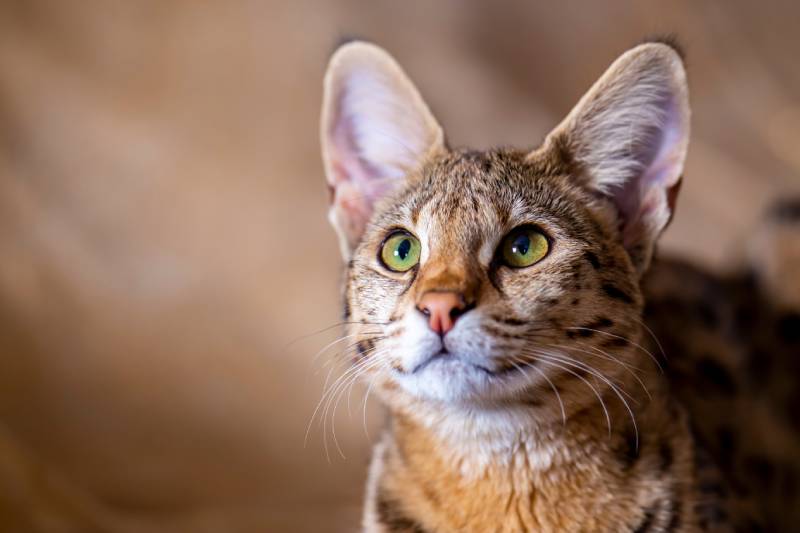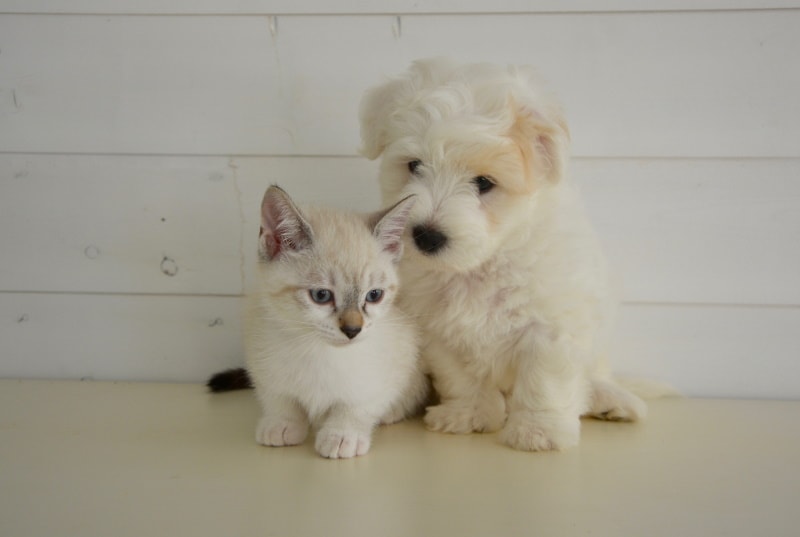10 Signs Your Cat Trusts You & How To Bond With Them

Updated on

Knowing whether your cat loves and trusts you is something that all cat owners wonder about occasionally. With their aloof and often strange body language, it’s easy to think that your cat is only hanging around because they’re after food. But cats do learn to trust their owners, and they also have unique ways of showing their adoration.
Understanding your cat’s body language will show you just how much you mean to your feline. This list includes 10 signs that your cat trusts you, no matter what their too-cool demeanor might first suggest.
The 10 Signs Your Cat Trusts You
1. Always Being Nearby
Domestic cats have the dubious honor of being both prey and incredibly skilled predators.1 Due to this, they know how important it is to stay safe and feel secure. Trust plays a big part in how safe your cat feels at home. The more they trust you, the more willing they are to follow you everywhere.
Some cat breeds might be more prone to demonstrating this behavior, while others remain aloof, but it’s still a common behavior. A four-legged shadow trotting after you wherever you go is a sure sign that your cat feels safe in your presence.
2. Chatting

Cats have different ways to express themselves through their meows. They can make demands like “playtime!” or “feed me!” and even request r a scratch behind the ears. Whatever the reason, cats know that the right type of meow gets them exactly what they want.
Not all their vocalizations are for making demands, though. Certain meows or chirps are simply greetings. If you find your cat chirping at you when you walk in through the front door or when they wake up from a nap, they might not be demanding food at all. They could just be saying “hi,” telling you that they missed you, or chatting about their day.
Some cats are chattier than others, but this doesn’t mean your quiet cat doesn’t care. They might not meow when they see you, but they will show that they trust you in other ways.
3. Giving Gifts
Outdoor cats are notorious for hunting local wildlife. You’ve probably experienced a few dead mice left on your doorstep or placed by your shoes. It’s simply a natural way for your cat to show that they trust you. They bring you their prey to show off their skills, provide for you as you do them, or try to teach you how to hunt.
Indoor cats do this too. They might not have as much access to real prey, but they can still bring you any toys that they subdue whenever they’re practicing their hunting skills.
4. Grooming

About 30–50% of a cat’s day is spent grooming themselves. It’s not just how they keep themselves clean, though. Grooming is a way for cats to relax and maintain their skin health. It’s also used as a social activity to build and strengthen bonds, which is known as “allogrooming” or “social grooming.”
Since grooming is part of a cat’s “love language,” some cats will groom their owners. They may lick your hands, arms, or hair whenever they get the chance. It’s an instinctive way for them to mark you as their own and show that they trust you.
5. Headbutting
Marking you with their scent is another way that cats show that they trust you. How they might do this includes bunting you with their head. They’ll tap their head against your hand, leg, or foot—or anywhere else they can reach—and then rub their face against you. This enables them to spread their scent onto you and their surroundings.
Your cat will do this to create a group or colony scent, bond with other cats and you, self-soothe, and mark their safe areas. By headbutting you, they’re not just asking for affection; they’re also telling you that they trust you and feel safe in your presence.
6. Kneading

A cat’s habit of kneading you or their favorite blanket goes back to their days as a kitten. Kittens will knead their mother whenever they’re hungry to stimulate milk flow. It’s an instinctual behavior that also serves to soothe them when they’re an adult. Kneading reminds them of the safe, secure feeling that they had as a kitten with their litter and mother.
It can be painful for your adult cat to knead you if they have a habit of using their claws, but your cat isn’t trying to hurt you. It’s their way of getting comfortable and demonstrating how safe they feel with you.
7. Love Biting
Biting is frequently seen as aggressive and most of the time, it is. However, cats also use it to show affection. It can be painful for unsuspecting fingers, though, even if the bites are gentle and not intended to draw blood or otherwise hurt you.
Love bites aren’t aggressive and won’t be accompanied by fearful or defensive behavior like hissing or scratching. Usually, love bites will accompany grooming and occur when your cat is completely relaxed. It’s something that can happen when they’re at ease around you.
That said, if you’re given a sharp nip during a friendly petting session, this can be a sign that your cat is tired of being petted, or it can be an inadvertent result of their attempt to groom you. If they’re licking your hand before digging their teeth in, they’re probably just trying to make sure you’re as clean as possible.
8. Purring

There are a few reasons that your cat will purr. Typically, your cat purrs when they’re content. Maybe they’re taking a nap on your pillow or are relaxing on your lap after a stressful day. Purring can also be used as a request for food by kittens or done by mother cats to let everyone know that everything’s okay.
If your cat’s purring is accompanied by signs of pain, it can be a sign of a health problem or injury. Cats will purr to soothe themselves or help themselves heal. For cats that purr when they’re completely relaxed, though, it’s safe to say that they’re simply happy to be with you.
9. Showing Their Belly
Cats like to feel safe, which means they won’t put themselves in a vulnerable position until they are certain that they’ll be safe when they do so. Showing their belly is one of the most trusting things that your cat can do.
This show of trust doesn’t always mean they want their tummy tickled, though. Some cats love to have their belly scratched, while others find it overstimulating. Your cat might roll over and show their belly as a show of faith, but you should pay close attention to how they react if you try to touch them when they’re vulnerable.
10. Slow Blinking

Many signs of trust from your cat rely on their body language. One of the most bemusing actions that your cat can do is blink at you slowly. This is a sedate way of communicating their affection for people and other cats that they trust.
Slow blinking or “kitty kisses” are a sign of a happy cat. Some cats demonstrate their affection by winking instead, but they’re just as content with their trust in you. When your cat winks or blinks at you, return the gesture by blinking back.
How to Build a Bond With Your Cat
Putting in the effort to build a strong bond with your cat will help them learn to trust you. Fortunately, your cat doesn’t need extravagant gifts to know that you care, and the following tips are simple but effective ways to speak their language.
Grab a Brush
Grooming is an important part of your cat’s routine, both for themselves and other cats. We humans might not groom each other to show our affection, but you can still take part in social grooming. Grab a brush, and spend time tending to your cat’s fur. They’ll appreciate the help and know that you’re telling them that they are part of the family.

Let Them Come to You
When your cat first comes home with you, they’ll likely be wary about their new surroundings. They might hide when you’re moving around, only explore when you’re asleep, and shy away whenever you try to coax them out.
Don’t force them to emerge sooner than they’re ready. Sit close by so they know that you’re there and maybe keep a few treats handy, but don’t scare them out of their safe spot. Once they’re sure you won’t hurt them, your new cat will emerge from their hiding spot to say hi.
Listen to Them
Talking to your cat should always be accompanied by listening and paying attention to what they’re telling you in return. They might be harder to read than your human friends, but their body language is quite obvious when you know what to look for.
Whenever you see their tail whipping back and forth, hear them hiss, or notice them tense when you touch them, take a step back. Even if you were enjoying cuddles, if your cat appears uncomfortable or wants to get away, let them go. They’ll take a bit of time to themselves and then come back for more affection when they’re ready.
Play Together
Spending time with your cat is the best way to form, nurture, and maintain a bond between you. You can sit together on the couch or let them stay on your bed when you’re sleeping. Having fun together is also a great way to build trust. Playing teaches your cat how to hunt, and you can help them learn by joining in.

Conclusion
Cats have a bit of a bad reputation for being aloof and uncaring. But they all have individual personalities and ways of showing that they care, and they will build bonds with their favorite people.
Your cat will show that they trust you through their actions, like showing their belly, grooming you, or bringing you their prey (even if it’s just their favorite toy). Some cats might not be as demonstrative as others, so we hope that this list helps you translate your cat’s language so you know that they trust you.
- See also: 7 Signs Your Cat Missed You (Explained)
Featured Image Credit: Veera, Shutterstock











